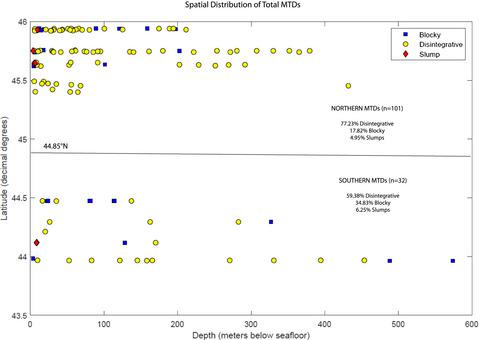当前位置:
X-MOL 学术
›
Basin Res.
›
论文详情
Our official English website, www.x-mol.net, welcomes your feedback! (Note: you will need to create a separate account there.)
Mass transport deposits in reflection seismic data offshore Oregon, USA
Basin Research ( IF 3.2 ) Pub Date : 2021-09-03 , DOI: 10.1111/bre.12611 Brandi L. Lenz 1 , Derek E. Sawyer 1
Basin Research ( IF 3.2 ) Pub Date : 2021-09-03 , DOI: 10.1111/bre.12611 Brandi L. Lenz 1 , Derek E. Sawyer 1
Affiliation

|
Submarine landslides associated with the Cascadia subduction zone offshore of the Pacific northwest United States and Canada represent significant natural geohazards. Mapping past submarine landslide deposits is critical for understanding present and future slope failure and tsunami hazard potential. We focus on the portion of Cascadia offshore Oregon to map the occurrences of submarine landslide deposits (mass transport deposits [MTDs]) in the subsurface using recent high-resolution reflection seismic data. We identified 133 MTDs and categorized them based on their present morphology inferred from their acoustic characteristics as disintegrative or blocky. Interestingly, nearly 76% of the MTDs are located in the northern Oregon margin and many of these are non-cohesive disintegrative deposits. MTDs are less common in the southern Oregon margin, however, they were also much larger and more cohesive than those found in the north. The differences are not likely to be related to differences in earthquake intensity but rather sedimentation rates and basin structures. Specifically, the northern Oregon margin is proximal to the sediment-delivery systems of the Columbia River and has landward verging fold-and-thrust structures, whereas the southern Oregon margin is relatively sediment starved and has seaward verging structures resulting in fewer steep ridges. Because of the higher sedimentation rates, the northern Oregon margin may be prone to more frequent and disintegrative types of slope failures. In contrast, the southern margin may have enhanced slope stability due to seismic strengthening and lower sedimentation rates. However, when slope failures do occur in the southern Oregon margin, they tend to be more cohesive and blocky. Therefore, even though there are fewer slope failures in the southern Oregon margin, there is still hazard potential because fast-moving cohesive slope failures can generate tsunami.
中文翻译:

美国俄勒冈州近海反射地震数据中的质量传输沉积物
与美国和加拿大太平洋西北部近海的卡斯卡迪亚俯冲带相关的海底滑坡是重大的自然地质灾害。绘制过去的海底滑坡沉积物对于了解当前和未来的斜坡破坏和海啸危险潜力至关重要。我们专注于俄勒冈州近海的卡斯卡迪亚部分,使用最近的高分辨率反射地震数据绘制地下滑坡沉积物(质量输送沉积物 [MTD])的分布图。我们确定了 133 个 MTD,并根据它们目前的形态对它们进行分类,这些形态从它们的声学特征中推断为崩解或块状。有趣的是,近 76% 的 MTD 位于俄勒冈州北部边缘,其中许多是非粘性崩解矿床。MTD 在俄勒冈州南部边缘不太常见,然而,它们也比在北方发现的更大、更有凝聚力。这些差异不太可能与地震强度的差异有关,而是与沉积速率和盆地结构有关。具体来说,俄勒冈州北部边缘靠近哥伦比亚河的沉积物输送系统,具有向陆边缘的褶皱和逆冲构造,而俄勒冈州南部边缘相对缺乏沉积物,并且具有朝向大海的边缘结构,导致陡峭的山脊较少。由于较高的沉积速率,俄勒冈州北部边缘可能更容易发生更频繁和解体的斜坡破坏类型。相反,由于地震强化和较低的沉积速率,南缘可能具有增强的边坡稳定性。然而,当俄勒冈州南部边缘确实发生斜坡破坏时,它们往往更具凝聚力和块状。因此,即使俄勒冈州南部边缘的斜坡破坏较少,但仍然存在潜在危险,因为快速移动的粘性斜坡破坏会产生海啸。
更新日期:2021-09-03
中文翻译:

美国俄勒冈州近海反射地震数据中的质量传输沉积物
与美国和加拿大太平洋西北部近海的卡斯卡迪亚俯冲带相关的海底滑坡是重大的自然地质灾害。绘制过去的海底滑坡沉积物对于了解当前和未来的斜坡破坏和海啸危险潜力至关重要。我们专注于俄勒冈州近海的卡斯卡迪亚部分,使用最近的高分辨率反射地震数据绘制地下滑坡沉积物(质量输送沉积物 [MTD])的分布图。我们确定了 133 个 MTD,并根据它们目前的形态对它们进行分类,这些形态从它们的声学特征中推断为崩解或块状。有趣的是,近 76% 的 MTD 位于俄勒冈州北部边缘,其中许多是非粘性崩解矿床。MTD 在俄勒冈州南部边缘不太常见,然而,它们也比在北方发现的更大、更有凝聚力。这些差异不太可能与地震强度的差异有关,而是与沉积速率和盆地结构有关。具体来说,俄勒冈州北部边缘靠近哥伦比亚河的沉积物输送系统,具有向陆边缘的褶皱和逆冲构造,而俄勒冈州南部边缘相对缺乏沉积物,并且具有朝向大海的边缘结构,导致陡峭的山脊较少。由于较高的沉积速率,俄勒冈州北部边缘可能更容易发生更频繁和解体的斜坡破坏类型。相反,由于地震强化和较低的沉积速率,南缘可能具有增强的边坡稳定性。然而,当俄勒冈州南部边缘确实发生斜坡破坏时,它们往往更具凝聚力和块状。因此,即使俄勒冈州南部边缘的斜坡破坏较少,但仍然存在潜在危险,因为快速移动的粘性斜坡破坏会产生海啸。


























 京公网安备 11010802027423号
京公网安备 11010802027423号